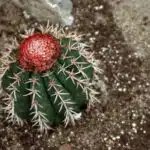Prickly pear cactus (Opuntia spp.) is a popular plant for growing both indoors and outdoors. This resilient plant can withstand a wide range of temperatures and conditions, making it an ideal choice for home gardeners who have limited gardening space. With the proper care and attention, prickly pear cactus can thrive in almost any environment. In this article, we will explore how to grow and care for prickly pear cactus inside your home.
As a specialist in botany and gardening, I know that growing plants in the home environment can be challenging. It is important to understand the needs of each species before attempting to cultivate them. Prickly pear cactus has some specific requirements that must be met in order to ensure its health and longevity. We will look at these requirements in detail, as well as some tips on how to best care for your prickly pear cactus once you have it established inside your home.
By understanding the needs of your prickly pear cactus, you can ensure that it thrives in its new environment. You will also be serving others by helping them learn how to successfully grow this beautiful desert plant indoors. Knowing how to properly care for prickly pear cacti not only benefits you personally but also helps others who wish to add this unique species of plant into their own homes. This article provides the information necessary for growing and caring for prickly pear cactus inside the comfort of your own home!
Identifying Prickly Pear Cactus
Identifying prickly pear cactus is an important first step for successful growth. Varieties of this cactus are found in many climates, ranging from dry and desert-like to more tropical regions. This cactus has an unusual appearance, with its flattened pads and small spines covering its surface. It’s also important to note that there are many different varieties of this plant, each with their own unique characteristics. With the right identification of your variety, you can ensure that you have the best chance for success when it comes to growing and caring for your prickly pear cactus.
To properly identify a prickly pear cactus, look at the size and shape of the pads on the plant, as well as the spines on them. The color of the pads can vary from green to yellow or even purple depending on the type you’ve selected. The spines may be long and needle-like or short and stubby. Additionally, some varieties may produce large yellow flowers during certain times of year. All these features will help you determine what kind of care your variety needs in order to thrive indoors or outdoors.
Lastly, it’s important to take into consideration where you plan on placing your new prickly pear cactus before selecting one from a nursery or garden center. Some varieties do better in full sun while others prefer more shade or humid climates. Knowing what conditions work best for your chosen variety can help to ensure its survival when brought home and placed in its new location. With proper identification, selection, and care techniques you can provide your prickly pear cactus with everything it needs to grow healthy and strong for years to come!
Selecting A Prickly Pear Cactus Variety
Rhetorical device used: Personification
When it comes to selecting a prickly pear cactus variety, the options can seem overwhelming and intimidating. But think of it this way: you are having a conversation with this living being, and it is telling you what it needs in order to survive and thrive. It’s as if each prickly pear cactus variety has its own unique personality, like an old friend who has known you for years providing you wise advice.
When selecting your prickly pear cactus variety, consider how much sunlight your environment provides. Some varieties need full sun exposure while others prefer partial shade or even complete shade. Also consider the amount of water each variety needs. While some varieties require frequent watering, others need little more than occasional misting.
Lastly, take into account the space available for your cactus. Some varieties grow tall and wide while others remain small and compact. Decide what size best fits your home or garden and select a variety accordingly. With all this information in mind, you’ll be able to find the perfect prickly pear cactus that suits your style and environment! Now that you have selected a prickly pear cactus variety, let’s discuss how to obtain one.
Obtaining Prickly Pear Cactus
Obtaining prickly pear cactus is like opening a present: there’s a sense of anticipation and excitement. For botanists and gardeners, the process of finding the perfect cactus for their purposes can be a rewarding one.
There are many places to find prickly pear cactus plants. Home improvement stores and nurseries typically have multiple varieties in stock, although selection may vary from store to store. It’s best to look for young plants; mature prickly pears can be difficult to get established in your home or garden. Online retailers also offer an array of options, including rare varieties not found in stores.
When shopping for a prickly pear cactus, it’s important to inspect the plant closely for signs of pests or disease. Prickly pears are susceptible to several types of fungi as well as spider mite infestations, so take care when selecting your specimen. If possible, ask questions about how long the plant has been in stock and what conditions it has been exposed to before making a purchase. With careful selection and proper care, you’ll soon be able to enjoy the unique beauty of these spiny succulents! Moving on, let’s explore the specifics of planting your new prickly pear cactus.
Planting Prickly Pear Cactus
Planting a prickly pear cactus is an exciting endeavor for any home gardener. It presents a unique challenge, as you must learn to care for this particular type of cactus, but the rewards are great when you see your plant thriving. To ensure the success of your prickly pear cactus, it’s important to understand the conditions needed for planting and how to prepare the soil correctly.
When planting your prickly pear cactus, it’s best to use a well-draining potting mix that contains sand or perlite, as these ingredients help retain moisture while promoting drainage. Make sure the soil is moist before planting so that it doesn’t dry out too quickly. Plant your cactus in a pot with enough room for growth, making sure there are plenty of drainage holes at the bottom of the container. Place your cactus in direct sunlight if possible – they enjoy full sun and will benefit greatly from several hours of direct light each day.
After planting, water your cactus immediately and then every few days throughout its growing season. During this time, be sure to check on your cactus regularly to make sure there are no signs of disease or pests. Prickly pears can become overgrown in small containers – if this happens, simply transplant them into larger pots with fresh soil. With proper care and attention, you’ll have a healthy prickly pear cactus in no time!
Fertilizing Prickly Pear Cactus
Ah, yes – the joy of caring for prickly pear cactus! It’s certainly an adventure, isn’t it? But with some knowledge and planning, you can have a magnificent specimen in your home. So let’s talk fertilizing!
When it comes to fertilizing a prickly pear cactus, make sure to use a balanced fertilizer that is low in nitrogen and high in phosphorus and potassium. The fertilizer should be applied every two weeks during the warmer months of spring and summer. During this time, you also want to ensure that the soil remains evenly moist at all times.
It’s important to note that too much fertilizer can burn the plant’s roots – something you definitely don’t want! So when applying fertilizer, be sure to keep it light and apply only a thin layer around the base of the plant. You should also avoid getting any on the spines as this can burn those as well.
As we move into discussing prickly pear cactus soil requirements, remember that proper care goes a long way in keeping your plant happy and healthy. With just a little bit of attention and knowledge about fertilization, you have everything you need for success with your prickly pear cactus!
Prickly Pear Cactus Soil Requirements
When it comes to cultivating a healthy prickly pear cactus indoors, an important factor to consider is its soil requirements. Specialist botanists and gardeners know that these drought-tolerant plants require well-drained soil in order to thrive. It’s essential to understand the different types of soil available, as well as the importance of proper watering techniques.
The best soil for prickly pear cacti is a mix of organic potting compost and coarse sand or gravel. This ensures that the roots are well aerated and not prone to waterlogging; overwatering can lead to root rot and other diseases that can harm the plant. Additionally, adding a light layer of mulch will help keep moisture in the ground longer and also help protect the surface of the cactus from freezing temperatures.
Finally, it’s important to remember that while they are adaptable plants, prickly pears do need occasional fertilizing in order to stay healthy and vibrant indoors. The nutrients provided by fertilizer can make all the difference in keeping your cacti alive and thriving! With proper soil requirements and fertilizing practices, you’ll have beautiful prickly pear cactus adorning your home for years to come.
Prickly Pear Cactus Sunlight Requirements
When it comes to the care and cultivation of prickly pear cactus, sunlight requirements are an important factor. Botanists and gardeners must pay attention to the amount of light that this species receives, as it can have a big impact on its health and growth. Generally speaking, these cacti thrive in bright, indirect light; however, they can tolerate full sun or some shade depending on their type.
It’s important to note that in the winter months, when there is less available sunlight, prickly pear cactus should be kept away from direct light sources like windows and skylights. Instead, try moving them to a location with bright fluorescent lights or other artificial sources of illumination. This will ensure that they still receive enough light for healthy growth without being exposed to too much direct sunlight which may cause damage.
Overall, prickly pear cactus does best when given enough light in order to thrive. When positioning your potted plants outdoors or indoors, make sure they get plenty of indirect sunlight throughout the day and avoid placing them too close to windows or other direct sources of light during winter months. With proper care and maintenance these plants can live long healthy lives! Now let’s move on to what watering requirements are essential for growing these unique succulents.
Prickly Pear Cactus Watering Requirements
Ah, the prickly pear cactus! A hardy, beautiful plant with an air of mystery about it. Watering a prickly pear correctly can seem like an art—but it doesn’t have to be. Read on for some tips on how to keep your prickly pears in top shape and give them the hydration they deserve.
To start, you should get into a regular watering routine that best fits your individual plant’s needs. Prickly pears prefer less frequent, deeper waterings and generally don’t need to be watered more than once every two weeks during the summer months. Make sure the soil is completely dry several inches down before giving it a good drink—the last thing you want is waterlogged roots!
In wintertime, when days are shorter and temperatures cooler, you can cut back on watering even more. A good rule of thumb is to wait until the soil is completely dry before giving your prickly pear another sip of H2O. Keep in mind that too much moisture can cause root rot, so if you live in an area with frequent rain or high humidity levels, you may want to consider moving your succulent indoors or providing extra drainage for the pot.
With the right balance of sunlight and water, your prickly pear will reward you with happy growth and plenty of blooms! Now let’s move onto examining temperature requirements for growing this unique cactus species…
Prickly Pear Cactus Temperature Requirements
It is a well-known fact among cactus experts that the prickly pear cactus requires temperatures of at least 60°F (15°C) to survive. This means that in most places, it can be grown as an indoor plant year-round. Furthermore, it’s important to note that the temperature should not fall below 50°F (10°C).
When it comes to the ideal temperature for your prickly pear cactus, you must take into account where it will be located in your home. If it is placed in a bright spot or near a window, then you’ll need to make sure the temperature stays within the range of 60-80°F (15-27°C). On the other hand, if it is placed in a darker area of your house, then you can let its temperature drop lower than 60°F (15°C).
To ensure that your prickly pear cactus thrives, monitor its environment and adjust the temperature accordingly. You can use a thermometer if needed to check on its exact temperature and make necessary adjustments. With proper care and attention to its environment, you can enjoy having this unique plant in your home all year round!
Prickly Pear Cactus Maintenance
Maintaining a prickly pear cactus requires vigilance, especially for those just starting out in the world of gardening. To ensure that your cactus thrives and remains healthy, it is essential to take certain precautionary measures. With the right care, you can keep your prickly pear cactus looking its best!
Firstly, when it comes to watering your prickly pear cactus, be sure not to overdo it. These plants prefer dry soil with periods of drought. Avoid allowing the soil to become soggy or waterlogged as this could cause root rot. Water when the soil has completely dried out and check for signs of moisture before watering again.
Next, place your plant in an area that receives indirect sunlight. Direct sunlight is too intense for these plants and will cause them to burn or fade in color. Additionally, fertilize sparingly as too much fertilizer can damage the roots of your plant and cause other health issues. A balanced fertilizer should be used every four weeks during the growing season and less often during winter months.
Finally, handle with care when repotting or moving your cactus around as these spines are sharp and can easily cause injury. Use gloves or thick cloths if needed, and make sure to provide adequate drainage when replanting into a larger pot. With proper handling, maintenance and care you can keep your prickly pear cactus happy and healthy!
Prickly Pear Cactus Pest And Disease Prevention
Although prickly pear cactus is a hardy plant, it’s still susceptible to pests and diseases. As with any living thing, prevention is the best way to ensure that your prickly pear cactus remains healthy and growing strong. Below are some tips for preventing pests and disease from affecting your cactus.
When dealing with pests, it’s important to first check for signs of infestation in the soil or on the plant itself. If you notice any signs of pests, such as webbing or small insects, remove them immediately using an insecticidal soap solution. When possible, try to avoid using chemical-based pesticides as they can harm beneficial insects that help keep other pest populations under control.
Another way to prevent pests and disease is by providing adequate ventilation in your growing space so that air can circulate around the plants. This will not only help reduce the risk of fungal diseases but also discourage certain bugs from taking up residence on your plant. Additionally, make sure to provide plenty of light for your prickly pear cactus so that it can stay healthy and strong.
It’s also a good idea to fertilize your prickly pear cactus on a regular basis to ensure that it has all the nutrients it needs for optimal growth and health. This will help prevent nutrient deficiencies which can lead to weaker plants that are more prone to pest infestations and disease problems. With these simple steps in place, you should be able to keep your prickly pear cactus looking its best for many years to come!
Prickly Pear Cactus Propagation
Have you ever wanted to learn how to propagate your prickly pear cactus? Growing a new plant from an existing one is a great way to increase your collection of these unique succulents. Here are the steps required for propagating a prickly pear cactus:
• Take a cutting from the existing plant – Choose a healthy stem with plenty of spines, and cut it off at the base of the stem. • Allow the cutting to callous – Place the cutting in a dry area and wait for at least one week until it forms a callous on its end. This will help prevent infection when planting. • Plant in soil – Once the cutting has calloused, place it in potting soil or cacti mix and water every other week. Be sure to provide adequate drainage.
Prickly pears have no serious disease issues but can be susceptible to pests like mealybugs and scale insects. Before propagating, inspect your plant for signs of infestation such as whitish spots on leaves or stems where bugs may inhabit. If detected, treat with an insecticide before propagating. With proper care, your prickly pear cactus should root quickly and thrive in its new environment! Now that you know how to propagate these plants, let’s take a look at pruning them for optimal growth.
Prickly Pear Cactus Pruning
Pruning a prickly pear cactus is essential for its overall health and beauty. By carefully tending to the pruning needs of your cactus, you can ensure that it grows with vigor and stays in top condition. Pruning these plants can also help them to flower more prolifically and gracefully. As a specialist in botany and gardening, I’m happy to provide some useful tips on how to properly prune your prickly pear cactus.
The first step is to identify any dead or dying branches that need to be removed. These should be removed at their base using sharp, clean scissors or shears. Doing so will prevent the spread of disease and help your plant look its best. It’s also important to remove branches that are growing too close together or overcrowding the pot they’re planted in. This will promote healthy growth and keep your plant from becoming unruly or unsightly over time.
Finally, it’s important to remember that less is more when it comes to pruning a prickly pear cactus – while you want to make sure you’re removing any dead or diseased branches, it’s not necessary (or desirable) to trim off healthy leaves or stems just for the sake of doing so! With care and attention, your prickly pear cactus will thrive for many years to come – but only if you treat it with respect and tenderness during the pruning process.
Prickly Pear Cactus Flowering
Flowering is the highlight of having a prickly pear cactus, and it’s essential to understand how to care for the plant in order to ensure that it blooms. Here are the key steps for helping your prickly pear cactus bloom:
• Provide plenty of sunlight: Prickly pears need at least 6 hours of direct sun each day, so make sure they’re placed in a sunny spot.
• Water regularly: Make sure to water your cactus once every two weeks, but don’t over-water it as this can cause root rot.
• Use a well-draining soil: Choose a soil that drains quickly, such as one with some sand or perlite added.
• Fertilize once a month: Use an all-purpose fertilizer for cacti and succulents or diluted liquid fertilizer during the growing season.
• Monitor temperatures: Avoid extreme temperatures and make sure not to let your prickly pear get too hot or cold.
Keeping these important points in mind will help ensure that your prickly pear cactus blooms successfully. With proper care, your plant should begin flowering within 2-3 years after planting—a reward well worth waiting for! Now that we’ve discussed how to get your prickly pear to flower, let’s move on to discussing repotting.
Repotting Prickly Pear Cactus
Repotting a prickly pear cactus is a straightforward process that requires some caution. Before you start, make sure you wear protective gear, like gloves and long-sleeved clothing to protect from the spines. Here are a few tips to keep in mind when repotting:
• Ensure that your pot is large enough for your cactus. Prickly pears grow quickly and will outgrow their pot if not given enough space.
• Add fresh, well-draining soil to the pot before adding your cactus. This will ensure that it has good drainage and can access adequate nutrients.
• Carefully remove your cactus from its current pot, taking care not to damage the roots or stems as much as possible.
• Place your cactus in the new pot and fill with soil until it is level with the surface of the plant’s crown. Water thoroughly after repotting and keep it in a warm, sunny spot for optimal growth.
When repotting prickly pear cacti, take extra precautions to protect yourself from the spines, as they can be quite sharp! Also make sure you choose an appropriately sized container for your plant; too small of a pot may lead to stunted growth or even death due to lack of nutrients or overcrowding. Additionally, be very gentle when handling the plant so as not to damage its delicate roots or stems. Finally, water thoroughly after repotting, and place in a warm sunny location for optimal growth and development over time!
Frequently Asked Questions
How Do I Know When To Harvest The Fruit From My Prickly Pear Cactus?
Harvesting fruit from a prickly pear cactus can be a daunting task. The process is laborious, but the reward of plump, sweet fruit makes it worth it! With a little know-how and some patience, you can easily determine when to harvest your cactus’s fruit.
Let me tell you, harvesting prickly pear cactus fruit is no easy feat. It requires time and patience to safely navigate the spines of the cactus and reach the succulent fruit within. But when you see the beautiful fruits that have grown on your prickly pear, you’ll be glad you waited!
Typically, these fruits ripen anywhere from late spring to early summer. The best way to know for sure when to harvest is to check for color changes in the fruits. When they start turning yellow or red, they may be ready for picking. You should also give them a gentle squeeze – if they are soft and juicy, then it’s time to start harvesting!
Are There Any Special Safety Precautions I Need To Take When Handling Prickly Pear Cactus?
Caring for a prickly pear cactus may seem intimidating, but with the right knowledge and precautions, it can be a safe and rewarding experience. To start your journey with this delightful succulent, here are six safety steps to keep in mind:
- Wear thick gloves when handling – Prickly pear cacti have sharp thorns that can cause scratches and even infections if not handled properly. Wearing thick gloves will help protect your skin from any potential injury.
- Keep away from children – Since kids may not understand the dangers of handling a prickly pear cactus, make sure to keep it out of their reach at all times to avoid any accidents.
- Wash hands after handling – Even if you’re wearing gloves, it is still important to wash your hands after touching the cactus as some of its parts may contain bacteria or other irritants that can cause skin irritation or infection.
As an experienced botanist and gardener, I understand how daunting it may seem to handle prickly pear cactus safely. But by following these simple safety precautions, you can enjoy growing this beautiful succulent without fear of injury or infection! Remember that prevention is always better than cure when dealing with any type of plant-related issues – don’t take any risks when caring for your prickly pear cactus!
Can I Propagate My Prickly Pear Cactus From Cuttings?
Propagating your own prickly pear cactus from cuttings is a great way to add more of this distinctive and hardy plant to your garden! As a specialist in botany and gardening, let me tell you how.
This task may seem intimidating – after all, who wants to handle those spiny things? – but with the right precautions, taking cuttings from an existing prickly pear cactus can be surprisingly easy. It’s almost like magic; before you know it, you’ll have a fresh new plant that will fill out your garden nicely.
First of all, I’d recommend wearing thick gloves while handling the cactus. Then, locate a healthy pad (or “joint”) on the cactus’s stem. Detach it carefully using pruning shears or a sharp knife – some of the spines may come off during this process, so be sure to keep them away from your skin. Plant the cutting in well-draining soil and water it lightly; within weeks, you should have a brand-new plant! With regular watering and plenty of sunlight, it will grow into its full potential for years to come.
So if you’re looking for an easy way to expand your prickly pear collection without buying new plants each time, propagating them yourself is definitely worth trying! Don’t be afraid of getting close to these fascinating cacti – just take proper safety precautions and watch them thrive in no time.
Is There A Difference Between The Pads Of The Prickly Pear Cactus And The Fruit?
Did you know that the prickly pear cactus has an estimated 1750 species? This is just one of the interesting facts about this fascinating plant. The pads of the prickly pear cactus are also known as cladodes and differ from its fruit. Here, we’ll discuss how to differentiate between the two.
Let’s start with the pads of the prickly pear cactus. These pads are usually found in clusters or rows along its stems and can be flat, cylindrical, or globular in shape. Cladodes may also have thorns on them and they come in a variety of colors including green, yellow, pink, purple, and red. Additionally, these pads are covered with tiny spines or bristles which help protect it against predators.
On the other hand, the fruit of the prickly pear cactus is quite different from its cladodes – first off, it’s much more colorful! The exterior skin of this fruit can range from yellow to red to purple in color while its flesh is typically a deep orange hue. Moreover, unlike its cladodes which contain spines and thorns to deter predators, this fruit does not have any sharp protrusions – instead it has small hair-like fibers on its surface for protection. Additionally, unlike its pads which are mainly used for photosynthesis purposes, the fruit is edible and full of health benefits!
So there you have it – when studying a prickly pear cactus plant take note of both its cladodes and fruits to be able to fully appreciate this unique plant! With careful watering and proper light exposure you can ensure that your prickly pear cactus stays healthy for years to come!
Are There Any Pests Or Diseases I Should Be Aware Of When Growing A Prickly Pear Cactus?
When growing a prickly pear cactus, it’s important to be aware of the potential for pests and diseases. Though these succulents are generally hardy and resilient, there are a few common ailments that can affect them.
The most common pest is the cactus moth, which lays its eggs on the pads of the plant. If left unchecked, the larvae will feed on the flesh of the pads, often resulting in unsightly scarring. Fortunately, this problem can usually be prevented with regular maintenance such as removing dead or damaged pads and keeping your plant clean.
Another potential issue is root rot, which occurs when too much moisture accumulates around the base of your plant. This can cause browning or wilting leaves and even death if not treated in time. To prevent this from happening, make sure you never over-water your cactus and provide adequate drainage so that excess water can escape. Lastly, avoid overwatering during colder months when your cactus may not be actively growing.
If you follow these simple tips and keep an eye out for any signs of pests or disease, you’ll have a beautiful prickly pear cactus that will thrive for years to come.
Conclusion
In conclusion, the prickly pear cactus is a hardy and relatively easy-to-care-for plant. It’s an excellent choice for anyone looking to add a unique and visually stunning addition to their indoor or outdoor garden. It’s important to take special precautions when handling this plant due to its spines, but once you get past that, it’s a fairly straightforward species to care for. With proper maintenance and regular harvesting of its delicious fruit, you can enjoy the bounty of your prickly pear cactus for years to come!
With just the right amount of light, water and fertilizer, your prickly pear cactus will grow at an almost miraculous rate – exponentially faster than any other type of succulent in your garden! Its pads are delectably sweet and filled with vitamins and minerals, making them a valuable addition to your diet. And with careful pruning and propagation from cuttings, you can create an entire forest of prickly pear cacti in no time – an awe-inspiring sight that could rival any fairytale fantasyland!





























